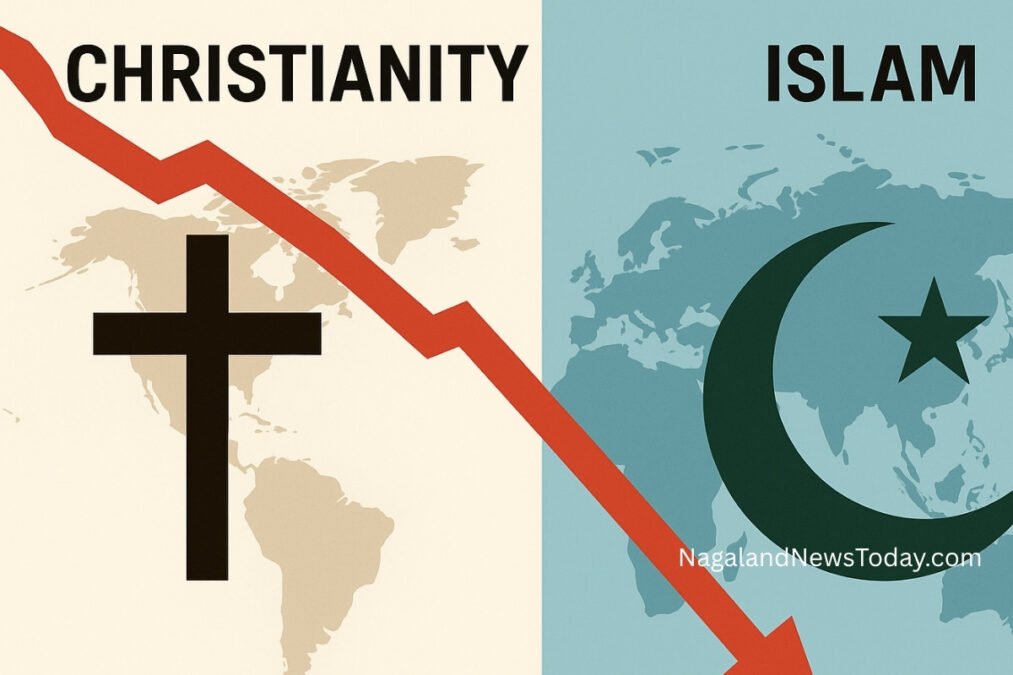Published by Aloto Naga | July 6, 2025
Global Religious Trends: Christianity Declines as Islam Emerges Fastest Growing Faith
In recent decades, global religious demographics have undergone notable shifts, with Christianity experiencing a steady decline in several regions while Islam continues to expand at an unprecedented rate. These changes are influenced by a complex mix of birth rates, age distribution, migration, and growing secularism, according to demographic researchers.
Christianity’s Decline in the West
Christianity remains the world’s largest religion, but it is witnessing a marked decrease in followers in countries across North America, Western Europe, and Oceania. This trend is driven by several factors including increased secularism, religious disaffiliation, aging populations, and fewer conversions.
A 2022 study by the Pew Research Center projected that in the United States alone, Christians could become a minority population by as early as 2070 if current trends continue. Similar declines have been recorded in countries like the United Kingdom, France, and Australia, where younger generations are increasingly identifying as religiously unaffiliated.
However, this decline is not universal. Christianity continues to grow robustly in parts of sub-Saharan Africa, Latin America, and Asia, fueled by higher birth rates and religious engagement. The number of Christians in Africa is projected to surpass that of any other continent by 2060.
Islam: The Fastest-Growing Religion
In contrast, Islam has emerged as the fastest-growing major religion in the world. According to Pew Research projections, the global Muslim population is expected to grow by 70% between 2015 and 2060, compared to a 34% growth rate for Christians over the same period.
Several factors account for this rise:
- High fertility rates: Muslims have the highest average fertility rate globally, estimated at 2.9 children per woman, compared to the global average of 2.4.
- Younger population: The median age of Muslims globally is about 24 years, compared to 30 for Christians, providing a demographic advantage in terms of long-term growth.
- High retention rates: Islam has a high rate of religious retention, with the majority of those born into the faith continuing to identify as Muslim.
Islam’s growth is most prominent in regions such as South Asia, West Africa, and parts of Europe due to immigration and conversion, although the latter accounts for a much smaller portion of growth.
Rise of the Religiously Unaffiliated
While Islam grows and Christianity shifts geographically, a third demographic—often overlooked—is also expanding: the religiously unaffiliated. This includes atheists, agnostics, and people who identify with “nothing in particular.”
Globally, the unaffiliated currently account for around 16% of the world’s population, but their growth is largely concentrated in economically developed regions, where religion is increasingly seen as a private or cultural identity rather than a doctrinal commitment.
Despite their growth, demographers do not expect the unaffiliated to surpass major religious groups globally due to lower birth rates and older average age among this population.
Future Projections: A Changing Religious Landscape
By 2060, projections suggest that:
- Islam could nearly equal or surpass Christianity in total population.
- The Christian share of the population will likely decline in developed countries but rise in regions like Africa.
- The “No Religion” demographic may continue to grow in influence in the West but not necessarily worldwide.
These trends underscore a broader transformation in the religious composition of the world. While no single projection can account for all geopolitical and cultural shifts, the trajectory indicates a future where religion—both in growth and decline—continues to shape global societies in profound ways.
Editor’s Note:
This article is based on independent reporting and analysis using publicly available data from reputable research institutions, including Pew Research Center, the World Religion Database, and UN demographic projections. No content has been copied from other websites. Religious topics are treated with the utmost respect and neutrality to foster informed and responsible discourse.

